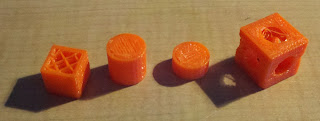So I decided with the new upgrade I should try something a little more complex. I downloaded the STL files for a knot. Which is one continuous loop printed on a little platform. The loop never touches it self and passes through the various openings. This is something that would be impossible to machine so it definitely shows the capabilities of 3d printing.
Time lapse of print. 1400mm of filament, 70min 15sec of print time
Finished, looks a little hairy in some sections but it will clean up nice
Just another view before cleanup
Post cleanup Top
Post Cleanup Side


























